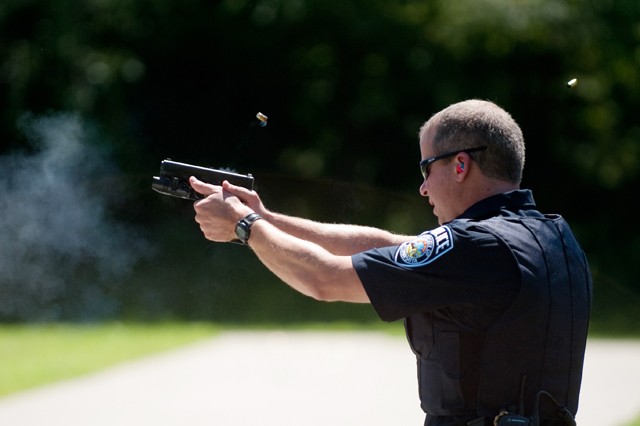“Fast, but accurate,” says University of Minnesota police Officer Aaron Churness, pointing to a gray target box at the end of the department’s Rosemount, Minn., shooting range. He’s instructing Lt. David Wilske on a close-combat pistol drill.
At the sound of the buzzer, Wilske fluidly pulls a .40 caliber semi-automatic Glock out of his right-side holster, chambers a round and squeezes off multiple shots in quick succession.
The stifling heat and glaring sun beat down on the outdoor range as Wilske and Churness survey the ripped-up paper target.
Tucked off a gravel road deep in UMore Park, the range hosts four University police training sessions like this one each year. Officers return to the park to undergo training and take a test that determines whether they get to keep their guns.
But the benefits of such rigorous training remain to be seen — not one University police officer has fired a shot in the past 10 years, Lt. Troy Buhta said.
Should the need ever arise, it’s imperative that officers know how to use the weapons to protect themselves and civilians, Churness said.
The next drill, meant to build accuracy with the AR-15 semi-automatic rifle, consists of hitting five balloons from long-range. At Churness’ signal, Wilske drops into “low-ready” position and coolly aims, gazing down the rifle’s sights. He easily pops the first two balloons and jams in a second magazine.
The clips clatter to the ground after three more shots, only two of them successful.
“Was that a concrete balloon?” Wilske asks, shaking his head at the remaining target bobbing in the wind.
The day’s training is called “top gun,” a nonmandatory contest where the quickest, most accurate officer wins. It’s meant to simulate a variety of scenarios police could encounter on the street.
In the past, officers have dragged 80-pound sandbags off the field to replicate rescuing a fallen comrade, practiced driving squad cars onto the range and shooting out of the windows or honed long-distance shooting with the AR-15.
“We don’t want to just come down here, line people up … and say, ‘Alright, shoot,’ and be done with it,” Churness said. “We want to put in some real life scenarios that might actually happen.’”
When new officers are hired by the University Police Department, they go through a 16-week training regimen where they are held increasingly responsible over time, followed by a year’s probation, Buhta said.
New officers go through about a week’s worth of training at the range, he said. Each officer shoots about 1,000 rounds during a 40-hour period.
Of the five officers sworn in last December, three have graduated to their probationary period, Buhta said. The department is looking to fill at least four additional spots because two of the original five left the program.
After they complete their initial training, University police officers go through about 30 hours of refreshers each year, ranging from personal self-defense to advanced driving techniques, Buhta said.
Although attending the “top gun” contest isn’t mandatory for University police, officers must achieve certain yearly benchmarks to keep their guns, Buhta said.
Both accuracy and proficiency shooting in cold weather with bulky gloves is required.
Buhta oversees “use of force” training administered to the roughly 50 University police officers. Topics include defensive tactics, TASER usage and shooting, among others.
Currently in the planning stages is a war-game style exercise called “active shooter” where groups of two or three officers fight against security monitors in unoccupied buildings. In previous years, dorms were used, but Buhta is looking to branch out into a new setting.
“[The officer’s] job is to go right for the shots. They’re not trying to help people that are hurt or wounded,” Buhta said. “Then after we clear the building, we bring in EMS to help the wounded or whatever else might be a problem.”
Specialized training has been helpful to University police in the past, he said.
During the 2009 Dinkytown riots, police used “pepperball” guns that shoot mace-filled rounds to move the crowds of revelers, Buhta said.
But “pepperball” training is expensive, Buhta said. So is ammunition.
In fiscal year 2010, the range, training and other miscellaneous expenses cost the department about $35,000.
The range is also used extensively by the FBI and Minneapolis SWAT.
The critical thinking required to complete the University’s course makes it valuable, Churness said. Officers are taught to multitask; for instance, running between targets while changing magazines could be a technique that preps them for a dangerous encounter.
“It’s more than just shooting paper,” he said.
Wilske readies himself at the final training station. The beep from Churness’ stopwatch alerts him it’s time. He runs to the first marker on the course and pumps three rounds into a human-shaped target at Churness’ command.
He runs closer, changing his magazine mid-stride. Churness shouts, “seven,” picking one of several targets downrange, and three more rounds rip through the target.
Wilske repeats the drill a final time slightly closer to the final target.
Of nine shots, seven hit.
His first question after the drill: How’d he score compared to Buhta?

















